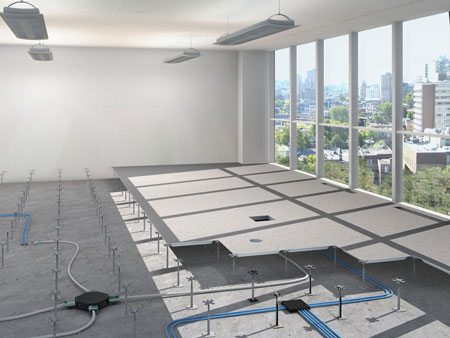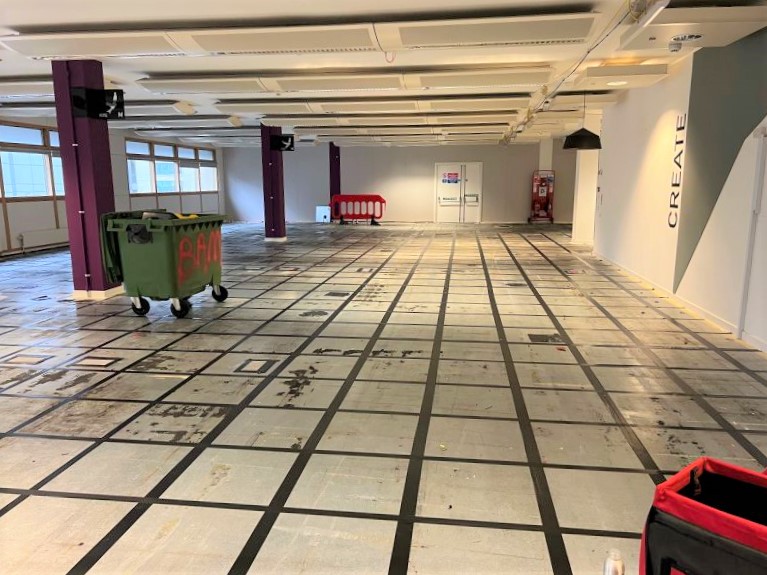The space beneath our feet could be performing an important function.
Plenum testing demonstrates the air tightness of the space below Raised Access Floors. Achieving air tightness in plenums is critical in achieving efficient air handling within buildings, and a rigorous test regime is required to meet design specifications.
What is a plenum?

Credit: Airfixture
A plenum is a void that is typically created beneath a Raised Access Floor in a place of work or education. Compared to using ductwork, plenums are a more efficient way of distributing fresh heated or conditioned air throughout large areas.
In recent times, indoor air quality is becoming increasingly important, and this is one of the strategies being employed. For this system to be efficient, there needs to be some degree of air tightness so that air is distributed in the way the plenum was designed.
Air tightness specifications
Many plenums are designed to use the specifications set out in the BSRIA guide, where the plenum must perform below 0.7 l/s/m² at 50 Pa.
This is often very hard to achieve due to the amount of cable and service penetrations. To achieve this, it is important to plan how all works around the plenum can be carried out to not affect the integrity. If the test does fail, then a very conscientious approach must be taken to complete remedial sealing across the entire perimeter, which is often costly and time-consuming.

Plenum Testing – how it works
The test has the same principle as a building air tightness test, with a few exceptions.
For a Raised Access Floor, two tests are often required. One with the floor tiles taped, and one without tape. This will allow us to work out the leakage of the plenum and the floor tiles separately.
Many buildings will also require testing to achieve a leakage rate at a different pressure, such as 25 Pa.
With a building air tightness test, it is easier to see where air is escaping by using smoke when inside the building. As it is hard to safely be inside a sealed plenum during a test, different techniques are used, mainly utilising experience and large smoke machines.
Tips and preparation
Before the taping takes place, we recommend sealing all the ductwork openings or the air handling units. To avoid any being missed, consult the drawings to identify where these are in the plenum.
During the installation of ductwork, it is common to miss out the sealing beneath the duct where it penetrates the wall, and this is then very difficult to seal at a later stage due to often being flush with the floor slab. When planning the work with the contractors, we’d recommend highlighting this area and installing an airtight seal beneath the duct.
Cabling considerations
Cable penetrations are often hard to effectively seal when bunched up in large trunks, or on cable trays. Again, seal beneath the cable tray before adding any cables.
When fitting the cables, especially when they are large in number, the best practice would be to lay a bead of mastic/sealant, then sit some of the cables into this so that they are not touching at the perimeter of the plenum. Once this has dried, apply another bead of mastic/sealant on top of these cables and repeat with another group of cables. This is going to be especially important in smaller plenums where there is less allowable leakage area available.
For conduits, as well as sealing around where they penetrate the wall, it is best practice to seal them inside too. This can be done by opening the conduit where it penetrates the wall for the best effect.
Plasterboard on internal and external walls may not be effectively sealed at the base, meaning air can escape from the plenum and up into the rest of the building. A continuous and thorough mastic seal across the base of the plasterboard before the Raised Access Floor is installed can be done quickly and effectively across the entire perimeter.
Need Help With Plenum Testing?
Just give us a call on 0330 055 34 05 , or email us at be@buildenergy.co.uk
